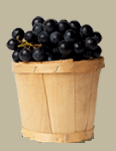YOUR GUIDE TO FINDING THE BEST WINE
We offer tips to Help you Succeed
at Wine Selection without really trying!!
Drinking wine is easy: simply tilt glass and swallow.
 Tasting wine is much more of a challenge. You
need special tools; the proper environment,
keen concentration, a good memory, good sense
of taste and vivid imagination too! That's
why a "wine connoisseur" fine wine
lover learns to taste wine so well.
Tasting wine is much more of a challenge. You
need special tools; the proper environment,
keen concentration, a good memory, good sense
of taste and vivid imagination too! That's
why a "wine connoisseur" fine wine
lover learns to taste wine so well.
We know that the effort we put into understanding and appreciating wine, as opposed to simply enjoying wine pays big dividends.
Really tasting wine adds an extra dimension to the basic daily routines of eating and drinking. Wine turns obligation into pleasure, daily necessity into a celebration of life.
Types of Wines and Descriptions
Barbera - Red grape variety. Most famous in the Piedmont region of NW Italy, where copious quantities are consumed with gusto. Lots of bright, sappy fruit and a tart, edgy quality that makes it a wonderful meal partner.
Cabernet Franc - Red grape variety and member of the Cabernet family. Bright raspberry fruit and occasionally leafy tobacco and green herb flavors. Typically softer than Cabernet Sauvignon.
Cabernet Sauvignon - Red grape variety. Widely planted with Bordeaux as its historical reference point. Often blended with Merlot and Cabernet Franc. Flavors run from red cherry to blackcurrant and are usually quite assertive.
Carignan - Red grape variety. The most common grape variety in France and widely planted in the Midi. Carignan tends to be low in acidity, extract and tannin making it useful for blending. Also planted in Algeria, Spain and California's Central Valley.
Charbono - Red grape variety. Obscure at best and probably better known in California than anywhere else, although its origins point to southern France. Capable of producing hearty, richly flavored reds with real personality.
Chardonnay - White grape variety. The white wine darling of the wine world. Widely planted and fairly successful in many areas of the world. Varies widely in style from the crisp lemon-lime-mineral flavors of classic Chablis to rich, oaky, buttery wines from California, Australia and other areas of the "new world."
Dolcetto - Red grape variety. In the dialect of Piedmont, northern Italy, Dolcetto means "little sweet one." This is not because the wines are sweet but because the grapes ripen relatively easily. With its dark plum and berry fruitiness and youthful appeal, Dolcetto is the sort of wine that is consumed daily in Piedmont. There are now small amounts of Dolcetto being made successfully outside Italy as well, particularly in California.
Gamay - Red grape variety. Although grown in the Loire Valley, the Ardeche, Switzerland, and California (alias Napa Gamay), Gamay is truly at its gulpable best in Beaujolais where it produces incomparably light, fruity and quaffable wines. Some wines from the Crus of Beaujolais can age well for 5-7 years.
Gewürztraminer - White grape variety that traces origins not to Germany as is often thought, but to the Alps of Northern Italy. The grape has one of the most exotic and flamboyant personalities of the wine world. Most successfully produced in the Alsace region of France.
Grenache - Red grape variety. Widely planted in southern France and in Spain and a frequent component in Rhone-style blends produced in other parts of the world. Flavors redolent of strawberry and red berry without a great deal of tannin.
Grüner Veltliner (GROO-ner FELT-lee-ner): a white grape variety. Widely planted in Austria, where a major renaissance of fine wine is taking place. Grüner Veltliner is among the more distinctive grape varieties. Typically fruity, dry, and medium to high in acidity, wines produced run the gamut from plonk to potentially extraordinary. The Grüner Veltliner signature is a hard to describe pungency that suggests stone fruits, citrus and mineral wrapped in fresh garden herbs.
Malbec (mahl-BECK): a red grape variety. In the Bordeaux region of France, in California, and in other parts of the world, the Malbec grape variety is usually used as a blending component with Cabernet-based wines. In Cahors, southwestern France, it is blended with Merlot. In Argentina, on the other hand, it is widely planted and frequently bottled solo. Malbecs tend to be fairly deep in color with dark berry flavors and a fair amount of tannin.
Malvasia (mal-vah-SEE-ah): a white grape variety. Malvasia is one of the most ancient grape varieties, and is thought by some to be a member of the aromatic Muscat family. Today grape vines alleged to be Malvasia show up in many wine-producing countries and under many name variations, although it is unlikely that all are genetically linked to the original. As finished wines Malvasias vary widely in style and color, from crisp, bone-dry whites to rich, unctuous dessert wines.
Marsanne (mahr-san): a white grape variety. Marsanne shares the spotlight with Roussanne in France's Rhone Valley. It is also widely planted in Australia but uncommon elsewhere. Produces wines of medium-to-full body with tropical fruit aromas and a fairly lush texture on the palate.
Merlot (mair-lo): a red grape variety. It is most famous in wines such as Chateau Petrus from the Pomerol region of Bordeaux. While capable of producing red wine with a soft, plummy character that is immediately appealing, it is also capable of producing wines of substantial intensity that will age for many years in the cellar.
Mourvedre (moor-ved'r): a red grape variety. Also known as Mataro, Mourvedre is widely planted in southern France, Spain and California. Mourvedre's most famous incarnation can perhaps be found in the vineyards of Bandol in Provence.
Muscat (muhs-kat): a white grape variety with a very extended family. The Muscat grape produces delicately perfumed wines, fine bubblies from northern Italy, and shamelessly hedonistic dessert wines from Australia and other parts of the world.
Nehbyehlas (neh-b'yoh-loh): the red grape variety responsible for Barolo and Barbaresco from the Piedmont region of northern Italy - which must be counted among the world's great red wines. Usually quite tannic but with age can mellow into wines of extraordinary complexity and finesse.
Petite Sirah (peh-teet seer-rah): a red grape variety. Historically confused with the true Syrah of the Rhone Valley of France, Petite Sirah is actually most successfully grown in California. Often accused of being one-dimensional, Petite Sirah can be quite delicious in the hands of the right winemaker.
Pinot Blanc (pee-no blahn): a white grape variety. Thought for many years to be a relative of Chardonnay, Pinot Blanc is actually a white variation of Pinot Noir. It runs the gamut from crisp, dry, citrusy whites to wines of sufficient richness and intensity that could easily pass for a well-oaked Chardonnay.
Pinot Gris/Grigio (pee-no gree - pee-no gree-d'jo): a white grape variety. Also related to Pinot Noir, the name literally translates as "gray Pinot." Typically at its richest in Alsace and at its leanest in northern Italy.
Pinot Noir (pee-no n'wahr): a red grape variety. Along with Cabernet Sauvignon, Pinot Noir is generally thought to be the world's finest red wine grape. Ranges in style from wines of amazing delicacy and grace to wines of voluptuous, velvety intensity. A wine for sensualists.
Riesling (reece-ling): a white grape variety. Perhaps the world's most misunderstood white grape variety and, in our estimation, the world's finest. Ranges in style from the crystalline purity of Germany's Mosel River Valley, to gloriously sweet dessert wines with every conceivable stopping point in between.
Sangiovese (san-joh-vay-zeh): a red grape variety. The most important red wine grape of Tuscany and the backbone of world-famous wines such as Chianti. Styles range from bright, simple cherry fruit to assertive, richly flavored reds with potential for years in the cellar.
Sauvignon Blanc (so-vee-n'yohn blahn): a white grape variety. The white wine relative of Cabernet Sauvignon and a white wine varietal with a particularly assertive personality. Flavors run from citrus-gooseberry intensity to round, rich, melon and fig.
Semillon (seh-mee-yohn): a white grape variety. Frequently used as a blending grape with Sauvignon Blanc, but capable of success on its own. Figures prominently in the wines of the Sauternes region of Bordeaux. Also produces excellent dry, full-boded whites in Australia.
Syrah (see-rah): a red grape variety. Ranks with Cabernet Sauvignon and Pinot Noir as one of the world's great red wine grapes. Most prominent in France's Rhone Valley with such legendary wines as Cote-Rotie and Hermitage. Also very successful in Australia, where it is known as Shiraz, and increasingly in other parts of the world as well.
Vernaccia (vair-naht-chah): a white grape variety. An ancient white wine variety best known in the wines of San Gimignano of Tuscany. Usually quite crisp and dry with moderate intensity.
Viognier (vee-oh-n'yay): a white grape variety. One of the world's most exotic white wine varieties with its perfumed nose of honey, stone fruits and tropical flowers. Can be quite lush and seductive in the mouth as well.
Zinfandel (zin-fan-del): a red grape variety. With origins not entirely established by wine world scholars, Zinfandel is nevertheless at home in California. Wine styles run the gamut from blush wines with just the barest hint of color to nearly opaque, inky monsters.





